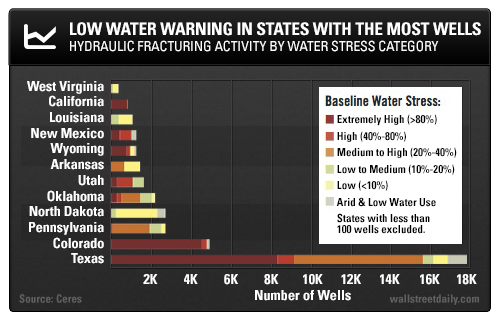Fracking’s Greatest Myth
Wall Street Daily | Sep 19, 2014 06:44AM ET
No one can deny that fracking holds enormous potential…
Experts estimate that this technique for harvesting Natural Gas from shale will add almost 50% to known recoverable natural gas resources and around 11% to known Oil reserves around the world.
All that energy potential comes at a price, however…
Fresh water, the most precious natural resource in the world, is a necessary component for fracking. And much of the investing community believes we’re running out – something that would prove to be more catastrophic than any energy-related calamity the world has ever seen.
But is this just a myth?
Who’s The Biggest Glutton?
What’s really perpetuating this idea of a water shortage is the fact that most shale plays are in very dry parts of the country.
According to the Ceres Investor Network, of the 40,000 fracking operations put in place over the past three years, three quarters are located in areas where water is scarce, and nearly 55% are in areas experiencing drought.
Fracking is particularly prevalent in California and Texas, the most water-challenged states in the country. While the drought in Texas isn’t as bad this year as it has been, California is on the verge of becoming a desert once again.
Plus, fracking in Texas and other states is expected to double in the next five years, while aquifer levels in plays like the Eagle Ford formation in the southern part of the state have dropped by hundreds of feet over the past few years.
The chart below shows how the states with the most wells tend to have high water stress.

Indeed, nearly 100 billion gallons of water are used annually for fracking operations, half of which is used in Texas alone. And that may seem like it’s a major strain on our water supply.
What most people don’t realize, however, is that this pales in comparison to the trillions of gallons used for farming and personal needs.
Farmers in places like California use more water than anywhere else in the country. The almond industry in that state alone uses a staggering 1.1 trillion gallons of water a year.
And Americans waste more water on their lawns in a month than the fracking industry uses in an entire year!
Location, Location, Location
In other words, there is no lack of water. Location is the real issue.
Since two of the major oil and gas fracking states also happen to be in the two most populous states in the United States – and those two states are also in a drought – water is becoming a concern.
This will play well for regions that are less populated, like the Bakken Shale in North Dakota, where the population of the entire state uses less water in a year than Manhattan.
Recycling water is also an option, but the cost benefits are negligible compared to using fresh water.
Thus, water competition between farmers, residents, and the oil and gas industry will rise in the coming years, leading to higher production costs in the states that are most drought stricken. Invest accordingly.
And “the chase” continues,
BY arim Rahemtulla
Trading in financial instruments and/or cryptocurrencies involves high risks including the risk of losing some, or all, of your investment amount, and may not be suitable for all investors. Prices of cryptocurrencies are extremely volatile and may be affected by external factors such as financial, regulatory or political events. Trading on margin increases the financial risks.
Before deciding to trade in financial instrument or cryptocurrencies you should be fully informed of the risks and costs associated with trading the financial markets, carefully consider your investment objectives, level of experience, and risk appetite, and seek professional advice where needed.
Fusion Media would like to remind you that the data contained in this website is not necessarily real-time nor accurate. The data and prices on the website are not necessarily provided by any market or exchange, but may be provided by market makers, and so prices may not be accurate and may differ from the actual price at any given market, meaning prices are indicative and not appropriate for trading purposes. Fusion Media and any provider of the data contained in this website will not accept liability for any loss or damage as a result of your trading, or your reliance on the information contained within this website.
It is prohibited to use, store, reproduce, display, modify, transmit or distribute the data contained in this website without the explicit prior written permission of Fusion Media and/or the data provider. All intellectual property rights are reserved by the providers and/or the exchange providing the data contained in this website.
Fusion Media may be compensated by the advertisers that appear on the website, based on your interaction with the advertisements or advertisers.